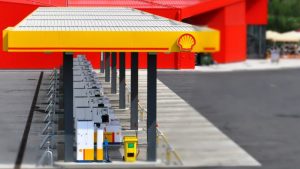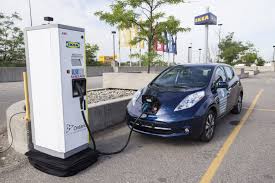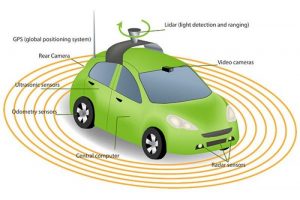Space Race and Future of Corporation
Posted onCo-Working Spaces
In a lobby of a Paris building the size of an Olympic swimming pool, workers huddle in discussion on tan-leather sofas, sheltered by an ornate geometric glass ceiling. Other sit at long wooden tables next to a winter garden, tapping away on laptops with the uniformity of typing pool.
This lavish set-up was once HQ of France’s largest nuclear company, Areva. As at June it has been a co-working space: the first Parisian outpost of WeWork, a company founded in 2010 by Israeli Adam Neumann.
Shared offices have come a long way from the rough-and-ready creative co-ops that sprang the concept of “co-working”. Big names in commercial real estate have entered the sector, assuming the fun-professional design vernacular and adding a Germanic twist to their branding (think “haus” rather than “house”).
Even Regus, the pioneer of the serviced office, has turned its hands to hot desks. The industry is longer a fringe. At its last investment round WeWork was deemed to be worth US$20 billion. Its service model includes IT support, 24-hour access and a programme of cultural events. And then there is the community, or the “ecosystem”.
Gig Economy
The success of this type of co-working concept is indicative of a whole raft of economic, cultural and social changes. Propelled by technology, the “gig economy” is evolving rapidly. A recent survey by the McKinsey Global Institute found that 162 million people in Europe and the US (20 to 30 per cent of the working-age population) engage in some form of independent work. Since the financial crisis, swathes of the workforce have chosen (or been pushed towards) a more agile, self-starting approach to earning a living. In the UK the level of self-employment increased from 3.8 million in 2008 to 4.6 million in 2015. For these people a job is no longer for life; there are no salaries, just income.
It is not the first time in history that the concept of work has shifted dramatically. “So much of how we structure our time, of what we now conceive of as work, was set up in the wake of the industrial revolution, “ says Andrew Scott, a professor of economics at the London Business School. He adds that the very notions of the office, the weekend, retirement and even leisure are relatively new inventions. Though the majority of us still had a conventional job, he says, the trend towards more flexible job is clear—and it is already having a fundamental effect. “We are seeing a configuration of time and space.”
The Future of the Corporation
Kathryn Myronuk, chair emeritus of finance and economics at the Silicon Valley-based Singularity University, thinks the slide towards flexible working is only at its infancy. ”Slightly into the future we will see decentralized management too, “ she says. “ The equivalent of a whole corporation might be brought together for a month to tackle a problem that might be less expensive and more nimble than the 20th-century model of corporations. In that case professions that today have certainty will become more unpredictable.”
The career, the firm and the office have been pillars of our society for decades. How will we cope without them? And are the co-working spaces that have sprung up a genuine attempt to grapple with the fundamental transformation of work as we know it—or opportunistic real-estate experiments? With rental prices, some companies appear to be cashing in on a new fiscally vulnerable freelance demographic. Often they are simply selling desk space to sole operators who can’t afford and might just be lonely.
Most economists are quick to point out the paradox of flexibility. For some it can be liberating, dynamic and lucrative; for others anxiety inducing and financially unstable. “ It is a bit like when the factory was introduced; we have to think about the human side of this, “ says Scott. “This is just a massive social experiment we don’t yet know the result of.”
Myronuk likens these shifts in working practices to “economic climate change” and calls for a similar risk-calculating approach to the uncertain outlook.
Members of Co-Working Spaces
There are companies that appear genuinely offer their members this vibrant community. NeueHouse, opened a co-working space a few blocks from New York’s Madison Square park five years ago and quickly amassed a members base drawing from the world of films, fashion, art and the media. Its second venture is the CBS Radio Building on Sunset Boulevard, Los Angeles, where members have access to to re-purposed sound stages and recording studios.
Meanwhile, others are seeking to build a meaningful social dimension into this burgeoning sector. Communal workshops that give users access to high-tech machines such as 3D printers, laser cutters and CNC machines (as well as training to use them) are also changing the picture. “We are making tool available that were previously only accessed on the university campus, “ says Thomas Ermacora, a trained architect and urbanist who runs Machines Room in London’s East End, one of the estimated 1,400 makerspaces globally.
In many ways co-working is a counter-cultural phenomenon come of age. The sector is now the subject of debate at big real-estate conferences, and property scions are seeking to replicate some of the most dynamic co-working projects that really did spring from an urge to collaborate (rather than to make money). Many might find, like the best restaurants, that it is a personal, grass-roots approach that is needed. Rather like art clubs that charge too much for any real artists to be able to afford the fees, the bottom could quickly fall out of creative ecosystems.
The Future
Some people really do just want to a quiet space to go and work and there is an argument that this what libraries should provide. With some small design tweaks, public-owned reading rooms around the world could be re-purposed to give agile (office-less) workers a landing pad.
In every cace, though, it is clear that a desk and a foosball are not enough to ensure the co-working space survives as a business model., particularly as competition gathers pace.
The issue of where we will all work in the future is far from certain; governments, architects and developers should start planning in earnest for the advent of a truly itinerant labour market. They need to plan for the unforeseeable.
Source: Sophie Grove. Space Race. MONOCLE November 2017, Issue 108.






